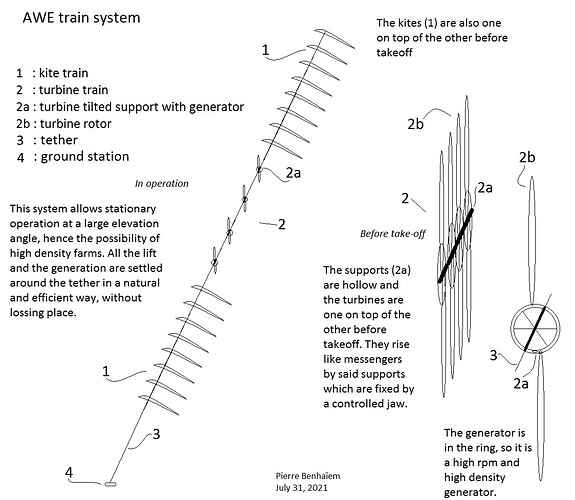I agree @gordon_sp, until the other side is examined.
Let us see the other side, so with not tilted turbines. I put a sketch of a AWE train system comprising kite trains and turbine trains. If we want about 1 MW at 10 m/s wind speed, 70 turbines of 10 m diameter each (78.5 m²) could be installed on the single tether. If less turbines are installed they would more undergo weight penalty. Say a turbine is 20 kg (to be optimist), comprising the generator at high rpm and density: 1.4 ton of turbines. The lifting kites have to lift such a weight (in addition to their own weight) even with low winds where the elevation angle will be far lower.
Kiwee seems to fly at about 60 degrees with an about 1 m² not tilted turbine and 4 m² lifting kite, producing 0.2 kW at 10 m/s wind speed, and 200-300 N thrust. Wind turbine Drag is about 70 newton: from this and from another document I have in paper format, the drag coefficient of a not tilted wind turbine could be something like 1.1.
To reach similar features at 1 MW scale, about 16 000 m² of lifting kites should be implemented, so 64 kites of 250 m² each. In yo-yo mode, by using only the kites, a similar value of 1 MW could be achieved without using crosswind motion, and about 10 MW with crosswind (soft) kites.
In addition stability and control are big concerns for stacked soft lifter kites in trains, rigid kites being more controllable and easier to implement in train, but heavier.
Hi @someAWE_cb , if tilted rotors generate large power in good conditions, even at 30-40° elevation angle, they could be relatively advantageous. At this stage, it is very difficult to answer yes or no given the multiplicity of factors. I just found it interesting that a not tilted turbine would not require more lifting kite area at a high elevation angle.
